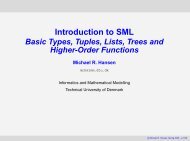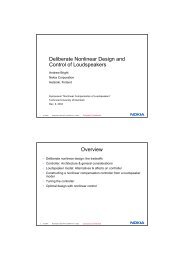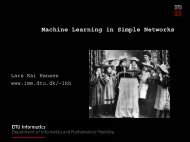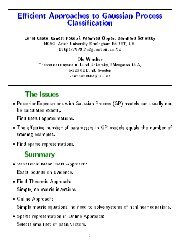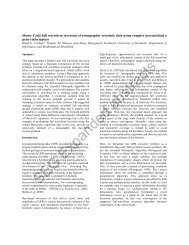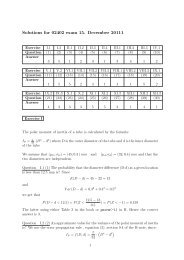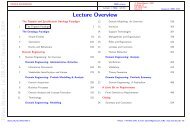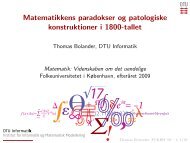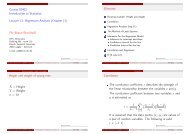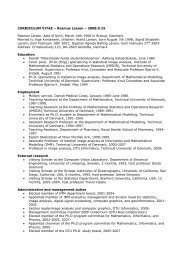Tensor decompositions in statistical signal processing
Tensor decompositions in statistical signal processing
Tensor decompositions in statistical signal processing
You also want an ePaper? Increase the reach of your titles
YUMPU automatically turns print PDFs into web optimized ePapers that Google loves.
Introduction Statistics <strong>Tensor</strong>s TheEnd App<strong>Tensor</strong> <strong>decompositions</strong><strong>in</strong> <strong>statistical</strong> <strong>signal</strong> process<strong>in</strong>gPierre ComonI3S, CNRS, University of Nice, Sophia-Antipolis, FranceJuly 2, 2009Pierre Comon MMDS - July 2009 1
Introduction Statistics <strong>Tensor</strong>s TheEnd App Model Goals ApplL<strong>in</strong>ear <strong>statistical</strong> modelwith⎧y :⎪⎨ s :A :b : ⎪⎩y = A s + b (1)K × 1 randomP × 1 random stat. <strong>in</strong>dependentK × P determ<strong>in</strong>isticerrorsPierre Comon MMDS - July 2009 2
Introduction Statistics <strong>Tensor</strong>s TheEnd App Model Goals ApplL<strong>in</strong>ear <strong>statistical</strong> modely = A s + b (1)with⎧y : K × 1 random “sensors”⎪⎨ s : P × 1 random stat. <strong>in</strong>dependent “sources”A : K × P determ<strong>in</strong>istic “mix<strong>in</strong>g matrix”b : errors “noise”⎪⎩Pierre Comon MMDS - July 2009 2
Introduction Statistics <strong>Tensor</strong>s TheEnd App Model Goals ApplL<strong>in</strong>ear <strong>statistical</strong> modely = A s + b (1)with⎧y : K × 1 random “sensors”⎪⎨ s : P × 1 random stat. <strong>in</strong>dependent “sources”A : K × P determ<strong>in</strong>istic “mix<strong>in</strong>g matrix”b : errors “noise”⎪⎩(may be removed for P large enough)Pierre Comon MMDS - July 2009 2
Introduction Statistics <strong>Tensor</strong>s TheEnd App Model Goals ApplOther writ<strong>in</strong>g[ sy = [A, I]b]Pierre Comon MMDS - July 2009 3
Introduction Statistics <strong>Tensor</strong>s TheEnd App Model Goals ApplOther writ<strong>in</strong>g[ sy = [A, I]b]which is of the noiseless formy = A s (2)with a larger dimension PPierre Comon MMDS - July 2009 3
Introduction Statistics <strong>Tensor</strong>s TheEnd App Model Goals ApplTax<strong>in</strong>omyProblems addressed <strong>in</strong> the literature:Pierre Comon MMDS - July 2009 4
Introduction Statistics <strong>Tensor</strong>s TheEnd App Model Goals ApplTax<strong>in</strong>omyProblems addressed <strong>in</strong> the literature:K ≥ P: “over-determ<strong>in</strong>ed”can be reduced to a square P × P regular mixtureA orthogonal or unitaryA square <strong>in</strong>vertiblePierre Comon MMDS - July 2009 4
Introduction Statistics <strong>Tensor</strong>s TheEnd App Model Goals ApplTax<strong>in</strong>omyProblems addressed <strong>in</strong> the literature:K ≥ P: “over-determ<strong>in</strong>ed”can be reduced to a square P × P regular mixtureA orthogonal or unitaryA square <strong>in</strong>vertibleK < P: “under-determ<strong>in</strong>ed”A rectangular with pairwise l<strong>in</strong>. <strong>in</strong>dependent columnsPierre Comon MMDS - July 2009 4
Introduction Statistics <strong>Tensor</strong>s TheEnd App Model Goals ApplTax<strong>in</strong>omyProblems addressed <strong>in</strong> the literature:K ≥ P: “over-determ<strong>in</strong>ed” → Approximation Pbcan be reduced to a square P × P regular mixtureA orthogonal or unitaryA square <strong>in</strong>vertibleK < P: “under-determ<strong>in</strong>ed”A rectangular with pairwise l<strong>in</strong>. <strong>in</strong>dependent columnsPierre Comon MMDS - July 2009 4
Introduction Statistics <strong>Tensor</strong>s TheEnd App Model Goals ApplTax<strong>in</strong>omyProblems addressed <strong>in</strong> the literature:K ≥ P: “over-determ<strong>in</strong>ed” → Approximation Pbcan be reduced to a square P × P regular mixtureA orthogonal or unitaryA square <strong>in</strong>vertibleK < P: “under-determ<strong>in</strong>ed” → Exact decompostionA rectangular with pairwise l<strong>in</strong>. <strong>in</strong>dependent columnsPierre Comon MMDS - July 2009 4
Introduction Statistics <strong>Tensor</strong>s TheEnd App Model Goals ApplGoalsSolely from realizations of observation vector yPierre Comon MMDS - July 2009 5
Introduction Statistics <strong>Tensor</strong>s TheEnd App Model Goals ApplGoalsSolely from realizations of observation vector yIn the stochastic framework:Pierre Comon MMDS - July 2009 5
Introduction Statistics <strong>Tensor</strong>s TheEnd App Model Goals ApplGoalsSolely from realizations of observation vector yIn the stochastic framework:Estimate matrix A: Bl<strong>in</strong>d identificationPierre Comon MMDS - July 2009 5
Introduction Statistics <strong>Tensor</strong>s TheEnd App Model Goals ApplGoalsSolely from realizations of observation vector yIn the stochastic framework:Estimate matrix A: Bl<strong>in</strong>d identificationEstimate realizations of the “source” vector s: Bl<strong>in</strong>dseparation/extraction/equalizationPierre Comon MMDS - July 2009 5
Introduction Statistics <strong>Tensor</strong>s TheEnd App Model Goals ApplGoalsSolely from realizations of observation vector yIn the stochastic framework:Estimate matrix A: Bl<strong>in</strong>d identificationEstimate realizations of the “source” vector s: Bl<strong>in</strong>dseparation/extraction/equalizationIn the determ<strong>in</strong>istic framework:Pierre Comon MMDS - July 2009 5
Introduction Statistics <strong>Tensor</strong>s TheEnd App Model Goals ApplGoalsSolely from realizations of observation vector yIn the stochastic framework:Estimate matrix A: Bl<strong>in</strong>d identificationEstimate realizations of the “source” vector s: Bl<strong>in</strong>dseparation/extraction/equalizationIn the determ<strong>in</strong>istic framework:Build a data tensor Y thanks to a diversity k, and decomposeit:Y ijk = ∑ A ip s jp B kppPierre Comon MMDS - July 2009 5
Introduction Statistics <strong>Tensor</strong>s TheEnd App Model Goals ApplGoalsSolely from realizations of observation vector yIn the stochastic framework:Estimate matrix A: Bl<strong>in</strong>d identificationEstimate realizations of the “source” vector s: Bl<strong>in</strong>dseparation/extraction/equalizationIn the determ<strong>in</strong>istic framework:Build a data tensor Y thanks to a diversity k, and decomposeit:Y ijk = ∑ A ip s jp B kppA and s are jo<strong>in</strong>tly estimatedPierre Comon MMDS - July 2009 5
Introduction Statistics <strong>Tensor</strong>s TheEnd App Model Goals ApplApplication areas1 Telecommunications (Cellular, Satellite, Military),2 Radar, Sonar,3 Biomedical (EchoGraphy, ElectroEncephaloGraphy,ElectroCardioGraphy)...4 Speech, Audio,5 Mach<strong>in</strong>e learn<strong>in</strong>g,6 Data m<strong>in</strong><strong>in</strong>g,7 Control...Pierre Comon MMDS - July 2009 6
Introduction Statistics <strong>Tensor</strong>s TheEnd App Uniqueness c.f. DecompositionIdentifiability & UniquenessUniqueness/Identifiability up to <strong>in</strong>herent ambiguitiesF<strong>in</strong>ite number of solutionsPierre Comon MMDS - July 2009 7
Introduction Statistics <strong>Tensor</strong>s TheEnd App Uniqueness c.f. DecompositionEquivalent representationsLet y admit two representationsy = A s and y = B zwhere s (resp. z) have <strong>in</strong>dependent components, and A (resp. B)have pairwise noncoll<strong>in</strong>ear columns.Pierre Comon MMDS - July 2009 8
Introduction Statistics <strong>Tensor</strong>s TheEnd App Uniqueness c.f. DecompositionEquivalent representationsLet y admit two representationsy = A s and y = B zwhere s (resp. z) have <strong>in</strong>dependent components, and A (resp. B)have pairwise noncoll<strong>in</strong>ear columns.These representations are equivalent if every column of A isproportional to some column of B, and vice versa.Pierre Comon MMDS - July 2009 8
Introduction Statistics <strong>Tensor</strong>s TheEnd App Uniqueness c.f. DecompositionEquivalent representationsLet y admit two representationsy = A s and y = B zwhere s (resp. z) have <strong>in</strong>dependent components, and A (resp. B)have pairwise noncoll<strong>in</strong>ear columns.These representations are equivalent if every column of A isproportional to some column of B, and vice versa.If all representations of y are equivalent, they are said to beessentially unique (permutation & scale ambiguities only).Pierre Comon MMDS - July 2009 8
Introduction Statistics <strong>Tensor</strong>s TheEnd App Uniqueness c.f. DecompositionIdentifiability & uniqueness theoremsLet y be a random vector of the form y = A s, where s p are<strong>in</strong>dependent, and A has non pairwise coll<strong>in</strong>ear columns.Pierre Comon MMDS - July 2009 9
Introduction Statistics <strong>Tensor</strong>s TheEnd App Uniqueness c.f. DecompositionIdentifiability & uniqueness theoremsLet y be a random vector of the form y = A s, where s p are<strong>in</strong>dependent, and A has non pairwise coll<strong>in</strong>ear columns.Identifiability theorem y can be represented asy = A 1 s 1 + A 2 s 2 , where s 1 is non Gaussian, s 2 is Gaussian<strong>in</strong>dependent of s 1 , and A 1 is essentially unique.Pierre Comon MMDS - July 2009 9
Introduction Statistics <strong>Tensor</strong>s TheEnd App Uniqueness c.f. DecompositionIdentifiability & uniqueness theoremsLet y be a random vector of the form y = A s, where s p are<strong>in</strong>dependent, and A has non pairwise coll<strong>in</strong>ear columns.Identifiability theorem y can be represented asy = A 1 s 1 + A 2 s 2 , where s 1 is non Gaussian, s 2 is Gaussian<strong>in</strong>dependent of s 1 , and A 1 is essentially unique.Uniqueness theorem If <strong>in</strong> addition the columns of A 1 arel<strong>in</strong>early <strong>in</strong>dependent, then the distribution of s 1 is unique upto scale and location <strong>in</strong>determ<strong>in</strong>acies.Pierre Comon MMDS - July 2009 9
Introduction Statistics <strong>Tensor</strong>s TheEnd App Uniqueness c.f. DecompositionExample of uniquenessLet s i be <strong>in</strong>dependent with no Gaussian component, and b i be<strong>in</strong>dependent Gaussian. Then the l<strong>in</strong>ear model below is identifiable,but A 2 is not essentially unique whereas A 1 is:( )( )( )s1 + s 2 + 2 b 1b1b1 + b= As 1 + 2 b 1 s+A 2 = A2 b 1 s+A 232 b 1 − b 2withA 1 =( 1 11 0) ( 2 0, A 2 =0 2)and A 3 =( 1 11 −1)Hence the distribution of s is essentially unique.But (A 1 , A 2 ) not equivalent to (A 1 , A 3 ).Pierre Comon MMDS - July 2009 10
Introduction Statistics <strong>Tensor</strong>s TheEnd App Uniqueness c.f. DecompositionExample of non uniquenessLet s i be <strong>in</strong>dependent with no Gaussian component, and b i be<strong>in</strong>dependent Gaussian. Then the l<strong>in</strong>ear model below is identifiable,but the distribution of s is not unique because a 2 × 4 matrixcannot be full column rank:( )s1 + s 3 + s 4 + 2 b 1= As 2 + s 3 − s 4 + 2 b 2⎛⎜⎝⎞s 1s 2⎟s 3 + b 1 + b 2s 4 + b 1 − b 2⎛⎠ = A ⎜⎝s 1 + 2 b 1s 2 + 2 b 2s 3s 4⎞⎟⎠withA =( 1 0 1 10 1 1 −1)Pierre Comon MMDS - July 2009 11
Introduction Statistics <strong>Tensor</strong>s TheEnd App Uniqueness c.f. DecompositionCharacteristic functionsFirst c.f.Pierre Comon MMDS - July 2009 12
Introduction Statistics <strong>Tensor</strong>s TheEnd App Uniqueness c.f. DecompositionCharacteristic functionsFirst c.f.Real Scalar: Φ x (t) def = E{e ı tx } = ∫ u eı tu dF x (u)Pierre Comon MMDS - July 2009 12
Introduction Statistics <strong>Tensor</strong>s TheEnd App Uniqueness c.f. DecompositionCharacteristic functionsFirst c.f.Real Scalar: Φ x (t) def = E{e ı tx } = ∫ u eı tu dF x (u)Real Multivariate: Φx(t) def = E{e ı tT x } =∫u eı tT u dF x(u)Pierre Comon MMDS - July 2009 12
Introduction Statistics <strong>Tensor</strong>s TheEnd App Uniqueness c.f. DecompositionCharacteristic functionsFirst c.f.Real Scalar: Φ x (t) def = E{e ı tx } = ∫ u eı tu dF x (u)Real Multivariate: Φx(t) def = E{e ı tT x } =∫u eı tT u dF x(u)Second c.f.Pierre Comon MMDS - July 2009 12
Introduction Statistics <strong>Tensor</strong>s TheEnd App Uniqueness c.f. DecompositionCharacteristic functionsFirst c.f.Real Scalar: Φ x (t) def = E{e ı tx } = ∫ u eı tu dF x (u)Real Multivariate: Φx(t) def = E{e ı tT x } =∫u eı tT u dF x(u)Second c.f.Ψ(t) def = log Φ(t)Pierre Comon MMDS - July 2009 12
Introduction Statistics <strong>Tensor</strong>s TheEnd App Uniqueness c.f. DecompositionCharacteristic functionsFirst c.f.Real Scalar: Φ x (t) def = E{e ı tx } = ∫ u eı tu dF x (u)Real Multivariate: Φx(t) def = E{e ı tT x } =∫u eı tT u dF x(u)Second c.f.Ψ(t) def = log Φ(t)Properties:Always exists <strong>in</strong> the neighborhood of 0Uniquely def<strong>in</strong>ed as long as Φ(t) ≠ 0Pierre Comon MMDS - July 2009 12
Introduction Statistics <strong>Tensor</strong>s TheEnd App Uniqueness c.f. DecompositionCharacteristic functions (cont’d)Properties of the 2nd Characteristic function (cont’d):Pierre Comon MMDS - July 2009 13
Introduction Statistics <strong>Tensor</strong>s TheEnd App Uniqueness c.f. DecompositionCharacteristic functions (cont’d)Properties of the 2nd Characteristic function (cont’d):if a c.f. Ψ x (t) is a polynomial, then its degree is at most 2 andx is Gaussian (Marc<strong>in</strong>kiewicz’1938)Pierre Comon MMDS - July 2009 13
Introduction Statistics <strong>Tensor</strong>s TheEnd App Uniqueness c.f. DecompositionCharacteristic functions (cont’d)Properties of the 2nd Characteristic function (cont’d):if a c.f. Ψ x (t) is a polynomial, then its degree is at most 2 andx is Gaussian (Marc<strong>in</strong>kiewicz’1938)Proof.complicated...Pierre Comon MMDS - July 2009 13
Introduction Statistics <strong>Tensor</strong>s TheEnd App Uniqueness c.f. DecompositionCharacteristic functions (cont’d)Properties of the 2nd Characteristic function (cont’d):if a c.f. Ψ x (t) is a polynomial, then its degree is at most 2 andx is Gaussian (Marc<strong>in</strong>kiewicz’1938)Proof.complicated...if (x, y) <strong>statistical</strong>ly <strong>in</strong>dependent, thenΨ x,y (u, v) = Ψ x (u) + Ψ y (v) (3)Pierre Comon MMDS - July 2009 13
Introduction Statistics <strong>Tensor</strong>s TheEnd App Uniqueness c.f. DecompositionCharacteristic functions (cont’d)Properties of the 2nd Characteristic function (cont’d):if a c.f. Ψ x (t) is a polynomial, then its degree is at most 2 andx is Gaussian (Marc<strong>in</strong>kiewicz’1938)Proof.complicated...if (x, y) <strong>statistical</strong>ly <strong>in</strong>dependent, thenΨ x,y (u, v) = Ψ x (u) + Ψ y (v) (3)Proof.Ψ x,y (u, v) = log[E{exp ı(ux + vy)}]= log[E{exp ı(ux)} E{exp ı(vy)}].Pierre Comon MMDS - July 2009 13
Introduction Statistics <strong>Tensor</strong>s TheEnd App Uniqueness c.f. DecompositionProblem posed <strong>in</strong> terms of Characteristic FunctionsIf s p <strong>in</strong>dependent and y = A s, we have the core equation:Ψ y (u) = ∑ ( )∑ψ p u q A qpp q(4)Proof.where ψ p (w) def = log E{exp ı(s p w)}.Pierre Comon MMDS - July 2009 14
Introduction Statistics <strong>Tensor</strong>s TheEnd App Uniqueness c.f. DecompositionProblem posed <strong>in</strong> terms of Characteristic FunctionsIf s p <strong>in</strong>dependent and y = A s, we have the core equation:Ψ y (u) = ∑ ( )∑ψ p u q A qpp q(4)Proof.where ψ p (w) def = log E{exp ı(s p w)}.Plug y = A s, <strong>in</strong> def<strong>in</strong>ition of Ψ y and getΦ y (u) def = E{exp ı(u T A s)} = E{exp ı( ∑ u q A qp s p )}p,qPierre Comon MMDS - July 2009 14
Introduction Statistics <strong>Tensor</strong>s TheEnd App Uniqueness c.f. DecompositionProblem posed <strong>in</strong> terms of Characteristic FunctionsIf s p <strong>in</strong>dependent and y = A s, we have the core equation:Ψ y (u) = ∑ ( )∑ψ p u q A qpp q(4)Proof.where ψ p (w) def = log E{exp ı(s p w)}.Plug y = A s, <strong>in</strong> def<strong>in</strong>ition of Ψ y and getΦ y (u) def = E{exp ı(u T A s)} = E{exp ı( ∑ u q A qp s p )}p,qS<strong>in</strong>ce s p <strong>in</strong>dependent, φ y (u) = ∏ p E{exp ı(∑ q u q A qp s p )}Pierre Comon MMDS - July 2009 14
Introduction Statistics <strong>Tensor</strong>s TheEnd App Uniqueness c.f. DecompositionFunction decompositionProblem:Equation (4) shows that we have to decompose a mutlivariatefunction <strong>in</strong>to a sum of univariate ones.Pierre Comon MMDS - July 2009 15
Introduction Statistics <strong>Tensor</strong>s TheEnd App Uniqueness c.f. DecompositionFunction decompositionProblem:Equation (4) shows that we have to decompose a mutlivariatefunction <strong>in</strong>to a sum of univariate ones.Weierstrass (1885), Stone (1948), Hilbert (1900), Kolmogorov(1957), Sprecher (1965), Hornik (1989), Cybenko (1989)...➽ But here, Ψ y and ψ p ’s are characteristic functions.Pierre Comon MMDS - July 2009 15
Introduction Statistics <strong>Tensor</strong>s TheEnd App Non symmetric Symmetric Determ<strong>in</strong>isticProblem seen as non symmetric tensor decompositionBack to core equation (4):Ψ y (u) = ∑ pψ p( ∑qu q A qp), u ∈ GAssumption: functions ψ p , 1 ≤ p ≤ P admit f<strong>in</strong>ite derivativesup to order d <strong>in</strong> a neighborhood of the orig<strong>in</strong>, conta<strong>in</strong><strong>in</strong>g G.Pierre Comon MMDS - July 2009 16
Introduction Statistics <strong>Tensor</strong>s TheEnd App Non symmetric Symmetric Determ<strong>in</strong>isticProblem seen as non symmetric tensor decompositionBack to core equation (4):Ψ y (u) = ∑ pψ p( ∑qu q A qp), u ∈ GAssumption: functions ψ p , 1 ≤ p ≤ P admit f<strong>in</strong>ite derivativesup to order d <strong>in</strong> a neighborhood of the orig<strong>in</strong>, conta<strong>in</strong><strong>in</strong>g G.Tak<strong>in</strong>g d = 3 as a work<strong>in</strong>g example:∂ 3 Ψ y∂u i ∂u j ∂u k(u) =P∑p=1A ip A jp A kp ψ (3)p (K∑u q A qp )q=1Pierre Comon MMDS - July 2009 16
Introduction Statistics <strong>Tensor</strong>s TheEnd App Non symmetric Symmetric Determ<strong>in</strong>isticProblem seen as non symmetric tensor decompositionBack to core equation (4):Ψ y (u) = ∑ pψ p( ∑qu q A qp), u ∈ GAssumption: functions ψ p , 1 ≤ p ≤ P admit f<strong>in</strong>ite derivativesup to order d <strong>in</strong> a neighborhood of the orig<strong>in</strong>, conta<strong>in</strong><strong>in</strong>g G.Tak<strong>in</strong>g d = 3 as a work<strong>in</strong>g example:∂ 3 Ψ y∂u i ∂u j ∂u k(u) =P∑p=1A ip A jp A kp ψ (3)p (K∑u q A qp )q=1of the form T ijkl = ∑ p A ip A jp A kp F lp , if L po<strong>in</strong>ts u l ∈ G.Pierre Comon MMDS - July 2009 16
Introduction Statistics <strong>Tensor</strong>s TheEnd App Non symmetric Symmetric Determ<strong>in</strong>isticProblem seen as symmetric tensor decomposition (1/2)If only the orig<strong>in</strong> <strong>in</strong> G, i.e. u l = 0, thenC ijk = ∑ pA ip A jp A kp f pMulti-l<strong>in</strong>ear relation relat<strong>in</strong>g cumulants.Pierre Comon MMDS - July 2009 17
Introduction Statistics <strong>Tensor</strong>s TheEnd App Non symmetric Symmetric Determ<strong>in</strong>isticProblem seen as symmetric tensor decomposition (2/2)Equivalent writ<strong>in</strong>g (still with d = 3 as work<strong>in</strong>g example)C =P∑f p h(p) ⊗ h(p) ⊗ h(p)p=1where h(p) def = pth column of A.Pierre Comon MMDS - July 2009 18
Introduction Statistics <strong>Tensor</strong>s TheEnd App Non symmetric Symmetric Determ<strong>in</strong>isticProblem seen as symmetric tensor decomposition (2/2)Equivalent writ<strong>in</strong>g (still with d = 3 as work<strong>in</strong>g example)C =P∑f p h(p) ⊗ h(p) ⊗ h(p)p=1where h(p) def = pth column of A.If vectors h(p) are not pairwise coll<strong>in</strong>ear, P is hopefullym<strong>in</strong>imal, i.e. equal to the rank of tensor CPierre Comon MMDS - July 2009 18
Introduction Statistics <strong>Tensor</strong>s TheEnd App Non symmetric Symmetric Determ<strong>in</strong>isticProblem seen as symmetric tensor decomposition (2/2)Equivalent writ<strong>in</strong>g (still with d = 3 as work<strong>in</strong>g example)C =P∑f p h(p) ⊗ h(p) ⊗ h(p)p=1where h(p) def = pth column of A.If vectors h(p) are not pairwise coll<strong>in</strong>ear, P is hopefullym<strong>in</strong>imal, i.e. equal to the rank of tensor C → conditionPierre Comon MMDS - July 2009 18
Introduction Statistics <strong>Tensor</strong>s TheEnd App Non symmetric Symmetric Determ<strong>in</strong>isticExpected rankFor an order-d symmetric tensor of dimension KNumber of equations: ( )K+d−1dNumber of unknowns: PKFor what P can one have an exact fit?Pierre Comon MMDS - July 2009 19
Introduction Statistics <strong>Tensor</strong>s TheEnd App Non symmetric Symmetric Determ<strong>in</strong>isticExpected rankFor an order-d symmetric tensor of dimension KNumber of equations: ( )K+d−1dNumber of unknowns: PKFor what P can one have an exact fit?“Expected rank”:R(K, d) def =⌈( K+d−1dK) ⌉(5)Pierre Comon MMDS - July 2009 19
Introduction Statistics <strong>Tensor</strong>s TheEnd App Non symmetric Symmetric Determ<strong>in</strong>isticClebsch’s statementAlfred Clebsch (1833-1872)For (d, K) = (4, 3), a generic tensor cannot be written as the sumof 5 rank-1 terms, even if #unknowns = 15 = #equationsPierre Comon MMDS - July 2009 20
Introduction Statistics <strong>Tensor</strong>s TheEnd App Non symmetric Symmetric Determ<strong>in</strong>isticHirschowitz theoremFrom Alexander-Hirschowitz thm (1995), one deduces [CGLM08]:Theorem For d > 2, the generic rank of a dth order symmetrictensor of dimension K is always equal to the expected rank¯R s = R(K, d) (6)except for (d, K) ∈ {(3, 5), (4, 3), (4, 4), (4, 5)}➽ Only a f<strong>in</strong>ite number of exceptions !Pierre Comon MMDS - July 2009 21
Introduction Statistics <strong>Tensor</strong>s TheEnd App Non symmetric Symmetric Determ<strong>in</strong>isticIdentifiabilityIdentifiability <strong>in</strong> wider sense: f<strong>in</strong>ite number of solutionsPierre Comon MMDS - July 2009 22
Introduction Statistics <strong>Tensor</strong>s TheEnd App Non symmetric Symmetric Determ<strong>in</strong>isticIdentifiabilityIdentifiability <strong>in</strong> wider sense: f<strong>in</strong>ite number of solutionsNecessary condition for identifiability: P ≤ R(K, d).Not sufficient, cf. Clebsch (1861), Hirschowitz (1995)Pierre Comon MMDS - July 2009 22
Introduction Statistics <strong>Tensor</strong>s TheEnd App Non symmetric Symmetric Determ<strong>in</strong>isticIdentifiabilityIdentifiability <strong>in</strong> wider sense: f<strong>in</strong>ite number of solutionsNecessary condition for identifiability: P ≤ R(K, d).Not sufficient, cf. Clebsch (1861), Hirschowitz (1995)Sufficient condition for almost sure identifiability:P < R(K, d).Pierre Comon MMDS - July 2009 22
Introduction Statistics <strong>Tensor</strong>s TheEnd App Non symmetric Symmetric Determ<strong>in</strong>isticIdentifiabilityIdentifiability <strong>in</strong> wider sense: f<strong>in</strong>ite number of solutionsNecessary condition for identifiability: P ≤ R(K, d).Not sufficient, cf. Clebsch (1861), Hirschowitz (1995)Sufficient condition for almost sure identifiability:P < R(K, d).NS condition for almost sure identifiability:( K+d−1)dP = = R(K, d) =K¯R sPierre Comon MMDS - July 2009 22
Introduction Statistics <strong>Tensor</strong>s TheEnd App Non symmetric Symmetric Determ<strong>in</strong>isticGeneric rank of symmetric tensorsSymmetric tensors of order d and dimension K:d K 2 3 4 5 6 7 82 2 3 4 5 6 7 83 2 4 5 8 10 12 154 3 6 10 15 21 30 42Pierre Comon MMDS - July 2009 23
Introduction Statistics <strong>Tensor</strong>s TheEnd App Non symmetric Symmetric Determ<strong>in</strong>isticDeterm<strong>in</strong>istic approachesModel:Y ijk = ∑ pA ip s jp B kpY = ∑ Pp=1a(p) ⊗ s(p) ⊗ b(p)Pierre Comon MMDS - July 2009 24
Introduction Statistics <strong>Tensor</strong>s TheEnd App Non symmetric Symmetric Determ<strong>in</strong>isticExpected rankFor an order-d symmetric tensor of dimensions K l , 1 ≤ l ≤ dNumber of equations: ∏ l K lNumber of unknowns: ∑ l K lP − (d − 1)PPierre Comon MMDS - July 2009 25
Introduction Statistics <strong>Tensor</strong>s TheEnd App Non symmetric Symmetric Determ<strong>in</strong>isticExpected rankFor an order-d symmetric tensor of dimensions K l , 1 ≤ l ≤ dNumber of equations: ∏ l K lNumber of unknowns: ∑ l K lP − (d − 1)P“Expected rank” aga<strong>in</strong> given by the ceil rule:⌈ ∏R(K 1 , .., K d ) defl=K ⌉l∑l K l − d + 1(7)Pierre Comon MMDS - July 2009 25
Introduction Statistics <strong>Tensor</strong>s TheEnd App Non symmetric Symmetric Determ<strong>in</strong>isticIdentifiabilityNecessary condition for identifiability:P ≤ R(K 1 , .., K d )Pierre Comon MMDS - July 2009 26
Introduction Statistics <strong>Tensor</strong>s TheEnd App Non symmetric Symmetric Determ<strong>in</strong>isticIdentifiabilityNecessary condition for identifiability:P ≤ R(K 1 , .., K d )Sufficient condition for almost sure identifiability:P < R(K 1 , .., K d )Pierre Comon MMDS - July 2009 26
Introduction Statistics <strong>Tensor</strong>s TheEnd App Non symmetric Symmetric Determ<strong>in</strong>isticIdentifiabilityNecessary condition for identifiability:P ≤ R(K 1 , .., K d )Sufficient condition for almost sure identifiability:P < R(K 1 , .., K d )For general tensors, generic rank ¯R not yet known everywhere.Pierre Comon MMDS - July 2009 26
Introduction Statistics <strong>Tensor</strong>s TheEnd App Non symmetric Symmetric Determ<strong>in</strong>isticGeneric rank of order 3 free tensors (1)K 2 3 4J 2 3 4 5 3 4 5 4 52 2 3 4 4 3 4 5 4 53 3 3 4 5 5 5 5 6 64 4 4 4 5 5 6 6 7 85 4 5 5 5 5 6 8 8 96 4 6 6 6 6 7 8 8 10I 7 4 6 7 7 7 7 9 9 108 4 6 8 8 8 8 9 10 119 4 6 8 9 9 9 9 10 1210 4 6 8 10 9 10 10 10 1211 4 6 8 10 9 11 11 11 1312 4 6 8 10 9 12 12 12 13Pierre Comon MMDS - July 2009 27
Introduction Statistics <strong>Tensor</strong>s TheEnd AppPerspectivesEfficient algorithms to compute f<strong>in</strong>ite set of solutionsPierre Comon MMDS - July 2009 28
Introduction Statistics <strong>Tensor</strong>s TheEnd AppPerspectivesEfficient algorithms to compute f<strong>in</strong>ite set of solutionsDetection of weak defectivity: rare cases when ∞ manysolutionsPierre Comon MMDS - July 2009 28
Introduction Statistics <strong>Tensor</strong>s TheEnd AppPerspectivesEfficient algorithms to compute f<strong>in</strong>ite set of solutionsDetection of weak defectivity: rare cases when ∞ manysolutionsConstruction of additional diversity: <strong>in</strong>creases orderPierre Comon MMDS - July 2009 28
Introduction Statistics <strong>Tensor</strong>s TheEnd AppPerspectivesEfficient algorithms to compute f<strong>in</strong>ite set of solutionsDetection of weak defectivity: rare cases when ∞ manysolutionsConstruction of additional diversity: <strong>in</strong>creases orderThanks for your attentionPierre Comon MMDS - July 2009 28
Introduction Statistics <strong>Tensor</strong>s TheEnd App Darmois proof Cumulants AH-thm refDarmois-Skitovich theorem (1953)TheoremLet s i be <strong>statistical</strong>ly <strong>in</strong>dependent random variables, and two l<strong>in</strong>earstatistics:y 1 = ∑ a i s i and y 2 = ∑ b i s iiiIf y 1 and y 2 are <strong>statistical</strong>ly <strong>in</strong>dependent, then random variables s kfor which a k b k ≠ 0 are Gaussian.NB: holds <strong>in</strong> both R or CPierre Comon MMDS - July 2009 29
Introduction Statistics <strong>Tensor</strong>s TheEnd App Darmois proof Cumulants AH-thm refProof of Darmois-Skitovich thmAssume [a k , b k ] not coll<strong>in</strong>ear and ψ p differentiable.Pierre Comon MMDS - July 2009 30
Introduction Statistics <strong>Tensor</strong>s TheEnd App Darmois proof Cumulants AH-thm refProof of Darmois-Skitovich thmAssume [a k , b k ] not coll<strong>in</strong>ear and ψ p differentiable.1 Hence ∑ Pk=1 ψ p(u a k + v b k ) = ∑ Pk=1 ψ k(u a k ) + ψ k (v b k )Trivial for terms for which a k b k = 0.From now on, restrict the sum to terms a k b k ≠ 0Pierre Comon MMDS - July 2009 30
Introduction Statistics <strong>Tensor</strong>s TheEnd App Darmois proof Cumulants AH-thm refProof of Darmois-Skitovich thmAssume [a k , b k ] not coll<strong>in</strong>ear and ψ p differentiable.1 Hence ∑ Pk=1 ψ p(u a k + v b k ) = ∑ Pk=1 ψ k(u a k ) + ψ k (v b k )Trivial for terms for which a k b k = 0.From now on, restrict the sum to terms a k b k ≠ 02 Write this at u + α/a P and v − α/b P :P∑k=1(ψ k u a k + v b k + α( a k− b )k) = f (u) + g(v)a P b PPierre Comon MMDS - July 2009 30
Introduction Statistics <strong>Tensor</strong>s TheEnd App Darmois proof Cumulants AH-thm refProof of Darmois-Skitovich thmAssume [a k , b k ] not coll<strong>in</strong>ear and ψ p differentiable.1 Hence ∑ Pk=1 ψ p(u a k + v b k ) = ∑ Pk=1 ψ k(u a k ) + ψ k (v b k )Trivial for terms for which a k b k = 0.From now on, restrict the sum to terms a k b k ≠ 02 Write this at u + α/a P and v − α/b P :P∑k=1(ψ k u a k + v b k + α( a k− b )k) = f (u) + g(v)a P b P3 Subtract to cancel Pth term, divide by α, and let α → 0:P−1∑( a k− b k) ψ (1)a P bk(u a k + v b k ) = f (1) (u) + g (1) (v)Pk=1for some univariate functions f (1) (u) and g (1) (u).Pierre Comon MMDS - July 2009 30
Introduction Statistics <strong>Tensor</strong>s TheEnd App Darmois proof Cumulants AH-thm refProof of Darmois-Skitovich thmAssume [a k , b k ] not coll<strong>in</strong>ear and ψ p differentiable.1 Hence ∑ Pk=1 ψ p(u a k + v b k ) = ∑ Pk=1 ψ k(u a k ) + ψ k (v b k )Trivial for terms for which a k b k = 0.From now on, restrict the sum to terms a k b k ≠ 02 Write this at u + α/a P and v − α/b P :P∑k=1(ψ k u a k + v b k + α( a k− b )k) = f (u) + g(v)a P b P3 Subtract to cancel Pth term, divide by α, and let α → 0:P−1∑( a k− b k) ψ (1)a P bk(u a k + v b k ) = f (1) (u) + g (1) (v)Pk=1for some univariate functions f (1) (u) and g (1) (u).Conclusion: We have one term lessPierre Comon MMDS - July 2009 30
Introduction Statistics <strong>Tensor</strong>s TheEnd App Darmois proof Cumulants AH-thm ref4 Repeat the procedure (P − 1) times and get:P∏( a 1− b 1) ψ (P−1)1(u a 1 + v b 1 ) = f (P−1) (u) + g (P−1) (v)a j b jj=2Pierre Comon MMDS - July 2009 31
Introduction Statistics <strong>Tensor</strong>s TheEnd App Darmois proof Cumulants AH-thm ref4 Repeat the procedure (P − 1) times and get:P∏( a 1− b 1) ψ (P−1)1(u a 1 + v b 1 ) = f (P−1) (u) + g (P−1) (v)a j b jj=25 Hence ψ (P−1)1(u a 1 + v b 1 ) is l<strong>in</strong>ear, as a sum of two univariatefunctions (ψ (P)1is a constant because a 1 b 1 ≠ 0).Pierre Comon MMDS - July 2009 31
Introduction Statistics <strong>Tensor</strong>s TheEnd App Darmois proof Cumulants AH-thm ref4 Repeat the procedure (P − 1) times and get:P∏( a 1− b 1) ψ (P−1)1(u a 1 + v b 1 ) = f (P−1) (u) + g (P−1) (v)a j b jj=25 Hence ψ (P−1)1(u a 1 + v b 1 ) is l<strong>in</strong>ear, as a sum of two univariatefunctions (ψ (P)1is a constant because a 1 b 1 ≠ 0).6 Eventually ψ 1 is a polynomial.Pierre Comon MMDS - July 2009 31
Introduction Statistics <strong>Tensor</strong>s TheEnd App Darmois proof Cumulants AH-thm ref4 Repeat the procedure (P − 1) times and get:P∏( a 1− b 1) ψ (P−1)1(u a 1 + v b 1 ) = f (P−1) (u) + g (P−1) (v)a j b jj=25 Hence ψ (P−1)1(u a 1 + v b 1 ) is l<strong>in</strong>ear, as a sum of two univariatefunctions (ψ (P)1is a constant because a 1 b 1 ≠ 0).6 Eventually ψ 1 is a polynomial.7 Lastly <strong>in</strong>voke Marc<strong>in</strong>kiewicz theorem to conclude that s 1 isGaussian.Pierre Comon MMDS - July 2009 31
Introduction Statistics <strong>Tensor</strong>s TheEnd App Darmois proof Cumulants AH-thm ref4 Repeat the procedure (P − 1) times and get:P∏( a 1− b 1) ψ (P−1)1(u a 1 + v b 1 ) = f (P−1) (u) + g (P−1) (v)a j b jj=25 Hence ψ (P−1)1(u a 1 + v b 1 ) is l<strong>in</strong>ear, as a sum of two univariatefunctions (ψ (P)1is a constant because a 1 b 1 ≠ 0).6 Eventually ψ 1 is a polynomial.7 Lastly <strong>in</strong>voke Marc<strong>in</strong>kiewicz theorem to conclude that s 1 isGaussian.8 Same is true for any ψ p such that a p b p ≠ 0: s p is Gaussian.Pierre Comon MMDS - July 2009 31
Introduction Statistics <strong>Tensor</strong>s TheEnd App Darmois proof Cumulants AH-thm ref4 Repeat the procedure (P − 1) times and get:P∏( a 1− b 1) ψ (P−1)1(u a 1 + v b 1 ) = f (P−1) (u) + g (P−1) (v)a j b jj=25 Hence ψ (P−1)1(u a 1 + v b 1 ) is l<strong>in</strong>ear, as a sum of two univariatefunctions (ψ (P)1is a constant because a 1 b 1 ≠ 0).6 Eventually ψ 1 is a polynomial.7 Lastly <strong>in</strong>voke Marc<strong>in</strong>kiewicz theorem to conclude that s 1 isGaussian.8 Same is true for any ψ p such that a p b p ≠ 0: s p is Gaussian.NB: also holds if ψ p not differentiablePierre Comon MMDS - July 2009 31
Introduction Statistics <strong>Tensor</strong>s TheEnd App Darmois proof Cumulants AH-thm refDef<strong>in</strong>ition of CumulantsMoments:defµ r = E{x r } = (−ı) r ∂ r ∣Φ(t) ∣∣∣t=0∂t rPierre Comon MMDS - July 2009 32
Introduction Statistics <strong>Tensor</strong>s TheEnd App Darmois proof Cumulants AH-thm refDef<strong>in</strong>ition of CumulantsMoments:Cumulants:C x (r)defdefµ r = E{x r } = (−ı) r ∂ r ∣Φ(t) ∣∣∣t=0∂t r= Cum{x, . . . , x} = (−ı) r ∂ r Ψ(t)} {{ }∂t rr times∣∣∣∣t=0Pierre Comon MMDS - July 2009 32
Introduction Statistics <strong>Tensor</strong>s TheEnd App Darmois proof Cumulants AH-thm refDef<strong>in</strong>ition of CumulantsMoments:Cumulants:C x (r)defdefµ r = E{x r } = (−ı) r ∂ r ∣Φ(t) ∣∣∣t=0∂t r= Cum{x, . . . , x} = (−ı) r ∂ r Ψ(t)} {{ }∂t rr times∣∣∣∣t=0Relationship between Moments and Cumulants obta<strong>in</strong>ed byexpand<strong>in</strong>g both sides <strong>in</strong> Taylor series:log Φ x (t) = Ψ x (t)Pierre Comon MMDS - July 2009 32
Introduction Statistics <strong>Tensor</strong>s TheEnd App Darmois proof Cumulants AH-thm refPolynomial <strong>in</strong>terpolationAlexander-Hirschowitz Theorem (1995) Let L(d, m) be thespace of hypersurfaces of degree at most d <strong>in</strong> m variables. Thisspace is of dimension D(m, d) def = ( )m+d − 1.Theorem Denote {p i } K given dist<strong>in</strong>ct po<strong>in</strong>ts <strong>in</strong> the complexprojective space P m . The dimension of the l<strong>in</strong>ear subspace ofhypersurfaces of L(d, m) hav<strong>in</strong>g multiplicity at least 2 at everypo<strong>in</strong>t p i is:D(m, d) − K(m + 1)except for the follow<strong>in</strong>g cases:• d = 2 and 2 ≤ K ≤ m• d ≥ 3 and (m, d, K) ∈ {(2, 4, 5), (3, 4, 9), (4, 1, 14), (4, 3, 7)}dIn other words, there are a f<strong>in</strong>ite number of exceptions.Pierre Comon MMDS - July 2009 33
Introduction Statistics <strong>Tensor</strong>s TheEnd App Darmois proof Cumulants AH-thm refReferencesF. L. HITCHCOCK. “Multiple <strong>in</strong>variants and generalized rank of a p-way matrix or tensor.” J. Math. andPhys., 7(1):39–79, 1927.L. R. TUCKER. “Some mathematical notes for three-mode factor analysis.” Psychometrika, 31:279–311,1966.J. B. KRUSKAL. “Three-way arrays: Rank and uniqueness of tril<strong>in</strong>ear <strong>decompositions</strong>.” L<strong>in</strong>ear Algebra andApplications, 18:95–138, 1977.V. STRASSEN. “Rank and optimal computation of generic tensors.” L<strong>in</strong>ear Algebra Appl., 52:645–685, July1983.P. COMON and B. MOURRAIN. “Decomposition of quantics <strong>in</strong> sums of powers of l<strong>in</strong>ear forms.” SignalProcess<strong>in</strong>g, Elsevier, 53(2):93–107, September 1996.N. D. SIDIROPOULOS and R. BRO. “On the uniqueness of multil<strong>in</strong>ear decomposition of N-way arrays.” J.Chemometrics, 14:229–239, 2000.P. COMON. “<strong>Tensor</strong> <strong>decompositions</strong>.” In J. G. McWhirter and I. K. Proudler eds, Mathematics <strong>in</strong> SignalProcess<strong>in</strong>g V, pages 1–24. Clarendon Press, Oxford, UK, 2002.A. SMILDE, R. BRO, and P. GELADI. Multi-Way Analysis. Wiley, 2004.P. COMON, G. GOLUB, L-H. LIM, and B. MOURRAIN. “Symmetric tensors and symmetric tensor rank.”SIAM Journal on Matrix Analysis Appl., 30(3):1254–1279, 2008.P. COMON, J. M. F. ten BERGE, L. De LATHAUWER and J. CASTAING. “Generic and Typical Ranks ofMulti-Way Arrays.” L<strong>in</strong>ear Algebra Appl., 2009. See also http://arxiv.org/abs/0802.2371P. COMON, X. LUCIANI and A. de ALMEIDA. “<strong>Tensor</strong> <strong>decompositions</strong>, alternat<strong>in</strong>g least squares and othertales.” J. Chemometrics. 2009, special issue.Pierre Comon MMDS - July 2009 34
Introduction Statistics <strong>Tensor</strong>s TheEnd App Darmois proof Cumulants AH-thm refReferencesParticipants <strong>in</strong> ANR-06-BLAN-0074 “DECOTES” project:Signal team, Lab. I3S UMR6070, Univ. Nice and CNRSGalaad team, INRIA, UR Sophia-Antipolis - Méditerranée.Lab. LTSI U642, INSERM and Univ. Rennes 1Thalès CommunicationsPierre Comon MMDS - July 2009 35



